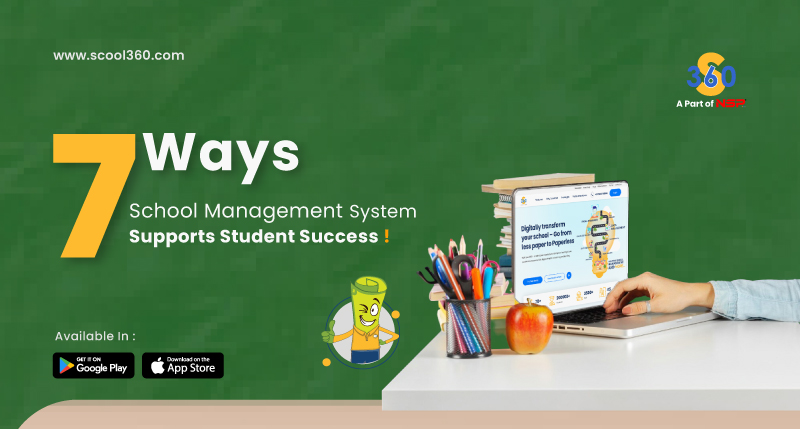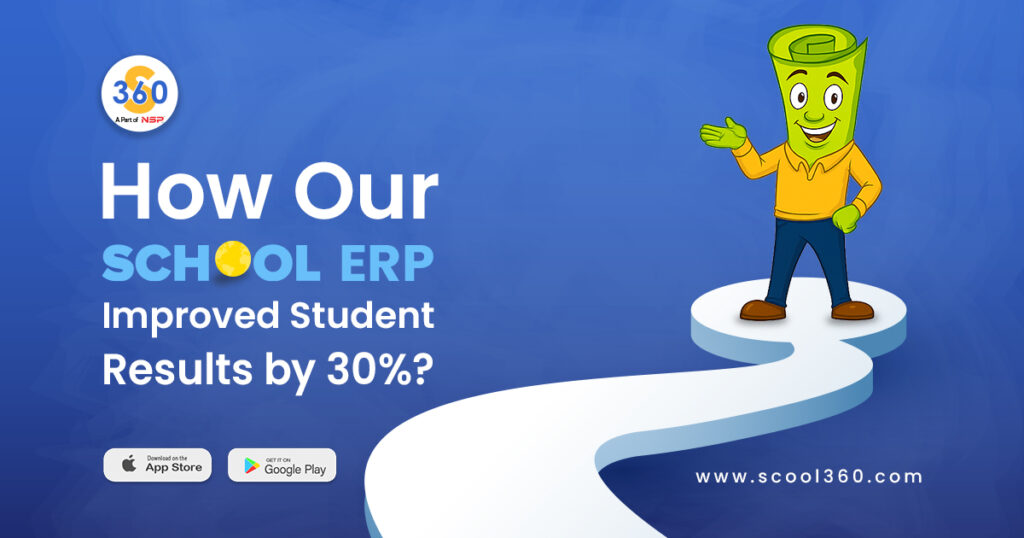Top Trends in School Management Software for 2025
July 2, 2025
Technology

As we move closer to 2025, School Management Software is evolving to meet the needs of a rapidly changing educational landscape. For school administrators, this means an exciting opportunity to streamline operations, enhance learning experiences, and improve overall school efficiency. The integration of advanced technologies like AI, cloud computing, and blockchain is making school management smarter and more secure than ever. Let us dive into the top trends in best school management software for 2025 and how they will impact school operations.
List Of Chapters
- AI Powered School Management Software for Student Success
- Cloud-Based Solutions for Flexibility and Scalability
- Hybrid Learning Models for Flexible Education
- Cloud-Based Systems for Secure and Efficient Record-Keeping
- AI-Powered Facial Attendance System for Efficient Monitoring
- IoT For Smart Campus Management
- Real-Time Analytics for Data-Driven Decision Making
- Mobile Access for On-the-Go Management
- Focus on Sustainability and Paperless Solutions
- Enhanced Parent and Teacher Communication
1. AI Powered School Management Software for Student Success
Artificial Intelligence (AI) is becoming an essential tool in education. In 2025, AI will be deeply integrated into School Management ERP Software to provide personalized learning experiences for students. By analyzing data such as grades, attendance, and engagement, AI will help administrators, teachers, and counselors identify students at risk of falling behind.
2. Cloud-Based Solutions for Flexibility and Scalability
Cloud computing capabilities have revolutionized how schools manage data and operations. In 2025, cloud-based school management systems will be the norm, allowing school administrators to manage everything from grades to attendance and communication anytime and anywhere in the world. The cloud provides the scalability that schools need, whether they are expanding, integrating modern technologies, or supporting a growing number of students.
Cloud systems also ensure seamless collaboration between teachers, administrators, and parents. With cloud-based platforms, school staff can access real-time data, track student progress, and communicate with stakeholders, all while ensuring data security.
3. Hybrid Learning Models for Flexible Education
The COVID-19 pandemic forced schools to adapt quickly to online and hybrid learning models, and in 2025, hybrid learning will no longer be just a temporary solution, it will be an integral part of the educational system. AI Powered School management systems will increasingly include tools for seamlessly managing both in-person and remote classes, creating a more flexible learning environment for students and staff.
For school administrators, hybrid learning will require systems that can handle both the logistical aspects of in-person education and the technical infrastructure for remote learning. This Educational ERP software will incorporate features like video conferencing integration, virtual attendance tracking, and real-time lesson sharing. Administrators will be able to make informed decisions about resource allocation, scheduling, and faculty management based on real-time data.
4. Cloud-Based Systems for Secure and Efficient Record-Keeping
Data security and transparency are essential in the modern educational environment. By 2025, Cloud Based School Management System will offer secure, efficient, and scalable record-keeping solutions. With cloud storage, schools can securely store critical information such as student grades, attendance records, and certifications, while maintaining easy access to authorized personnel.
Cloud solutions also offer backup and disaster recovery capabilities, protecting records from loss due to technical issues or disasters. Additionally, cloud-based systems will allow for seamless record transfers between institutions, ensuring that student data is easily accessible and up to date.
5. AI-Powered Facial Attendance System for Efficient Monitoring
In 2025, All the School Management Software Systems will increasingly be incorporating the latest Facial Recognition Attendance System for more accurate and efficient attendance tracking. This system will automatically record student attendance using facial recognition, eliminating the need for manual check-ins or traditional attendance sheets.
The AI-powered system can quickly identify students based on their facial features and check them with the class list, providing a seamless and error-free attendance process. Additionally, facial recognition of attendance can be integrated with security measures to enhance campus safety by identifying any unauthorized individuals on school premises.
6. IoT for Smart Campus Management
The Internet of Things (IoT) is transforming school campuses into smart environments. By 2025, IoT will be fully integrated into campus management systems, providing administrators with the tools to monitor and control various aspects of campus operations. From automated lighting and temperature control to real-time tracking of attendance using RFID tags, IoT will help schools create more efficient, sustainable, and connected campuses.
IoT integration will streamline resource management, reduce energy consumption, and improve the overall campus experience. Additionally, IoT-enabled systems will allow for predictive maintenance of equipment and facilities, ensuring that resources like computers, buses, and lab equipment are in good working order when needed.
Recommended For You: How To Choose A Best School Management Software
7. Real-Time Analytics for Data-Driven Decision Making
In 2025, school management systems will leverage real-time analytics to provide actionable insights for administrators. These analytics will cover everything from student performance and attendance trends to resource allocation and teacher effectiveness. Real-time dashboards will give administrators a comprehensive overview of school operations, enabling them to make informed, data-driven decisions.
For example, if attendance rates are slipping or if there are patterns of academic struggles among certain student groups, administrators will be able to identify these issues early and take corrective action. Real-time analytics will empower school leaders to manage resources more effectively, track progress against goals, and enhance the overall learning environment.
8. Mobile Access for On-the-Go Management
With mobile devices becoming a ubiquitous part of everyday life, school management systems are increasingly adopting mobile-first designs. This trend will continue into 2025, with school management software offering mobile access to key features like grade tracking, attendance, and communication tools. Administrators, teachers, and parents will be able to manage school operations from the palm of their hands, ensuring seamless access to critical information.
For school leaders, mobile access means they can stay connected to their school’s operations even when they are not physically on campus. Whether it is communicating with parents, monitoring student progress, or tracking operational tasks, administrators will be able to manage everything from their smartphones or tablets.
9. Focus on Sustainability and Paperless Solutions
As schools strive to reduce their environmental impact, school management systems will play a key role in driving sustainability. By 2025, schools will move toward paperless solutions, replacing physical documents with digital forms, online reports, and electronic communication. This shift will reduce paper waste and streamline administrative tasks.
For school administrators, going paperless means more efficient document management, faster processes, and a reduced environmental footprint. It also makes it easier to store and retrieve documents securely in the cloud, improving overall organizational efficiency.
10. Enhanced Parent and Teacher Communication
Parent involvement is critical to student success, and school management systems are increasingly incorporating features that facilitate better communication between parents, teachers, and school administrators. In 2025, School ERP platforms will offer robust parent portals that allow for easy access to academic performance, attendance, and school announcements. These portals will also enable parents to communicate directly with teachers, fostering a collaborative approach to student success.
For administrators, having a communication platform that streamlines parent-teacher interaction will help create a more transparent and inclusive school community. These platforms will reduce communication barriers, ensure that parents are well-informed, and encourage a stronger partnership between families and schools.
Want to see how Scool360 incorporates these 2025 trends? Book A Free Demo today.
Conclusion: Embracing Innovation for a Smarter Future
The trends shaping school management systems in 2025 are driven by the need for greater efficiency, personalization, and flexibility. For school administrators, embracing these trends will mean more streamlined operations, more engaged students, and more informed decision-making. Whether through AI-driven personalization, blockchain security, or IoT-enabled campuses, the future of Ed-tech software is poised to transform education and school administration in exciting new ways.
By leveraging these trends, school leaders can ensure their institutions are not just keeping up with the digital age but are at the forefront of innovation, creating better learning environments and supporting the success of every student.
Frequently Asked Questions [FAQ]
Q1. What are the key features of school management software in 2025?
Features include AI personalization, cloud-based operations, IoT integration, mobile access, real-time analytics, and facial recognition for attendance.
Q2. Is cloud-based school software secure for student data?
Yes, platforms like Scool360 follow strict security protocols, encrypted data transfers, and offer regular backups to protect student and staff information. Secure backups (no losing records if a computer crashes). Follow government rules for student privacy.
Q3. How does AI improve student learning in school ERP systems?
AI helps identify at-risk students, personalize learning paths, and provide real-time academic support through data analysis.
Q4. What is the role of IoT in smart school campuses?
IoT automates lighting, security, and resource tracking, making schools more efficient, safe, and sustainable.
Q5. Can parents use school management software to track student progress?
Absolutely. ERP platforms like Scool360 offer dedicated parent portals for grades, attendance, announcements, and direct teacher communication.
Previous Post
Top 10 Tips for Optimizing Your School’s Website
Recent News article
Fresh job related news content posted each day


